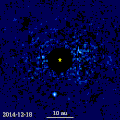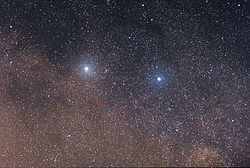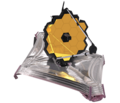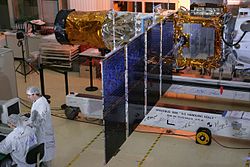Exoplanetary Circumstellar Environments and Disk Explorer (EXCEDE) is a proposed space telescope for NASA's Explorer program to observe circumstellar...
10 KB (364 words) - 20:19, 5 June 2025
A circumstellar disc (or circumstellar disk) is a torus, pancake or ring-shaped accretion disk of matter composed of gas, dust, planetesimals, asteroids...
29 KB (3,599 words) - 02:42, 24 June 2025
out of a nebula to create a young protostar orbited by a protoplanetary disk. There are eight planets within the Solar System; planets outside of the...
9 KB (821 words) - 23:08, 30 July 2025
onto the circumstellar disk around the host star. Material will flow from the edges of the circumstellar disk towards the planet in streams and around the...
30 KB (3,529 words) - 13:40, 1 August 2025
Disrupted planet (category Circumstellar disks)
of related gas, dust and debris, which may eventually surround the parent star in the form of a circumstellar disk or debris disk. As a consequence, the...
16 KB (1,512 words) - 16:53, 25 July 2025
to: A brand name of the medication ceftiofur Exoplanetary Circumstellar Environments and Disk Explorer, a planned space telescope This disambiguation...
178 bytes (52 words) - 05:30, 2 July 2024
telescopes Lists of spacecraft "The TOLIMAN mission: precision astrometry for exoplanetary discovery in the solar neighborhood". Archived from the original on 10...
27 KB (1,536 words) - 03:34, 13 March 2025
Network (PLANET/Robonet), Optical Gravitational Lensing Experiment (OGLE), and Microlensing Observations in Astrophysics (MOA) made a joint announcement...
14 KB (1,316 words) - 06:08, 17 July 2025
Kepler-1649c (section Mass, radius and temperature)
has a mass 1.2x times that of Earth, and has a radius of around 1.02 times that of Earth. Based on its mass and radius, it is likely a terrestrial planet...
10 KB (882 words) - 02:25, 20 June 2025
LHS 1140 (category Gliese and GJ objects)
arc annually. The star is over 5 billion years old and has only about 18% the mass of the Sun and 21% of its radius. LHS 1140's rotational period is 130 days...
16 KB (1,266 words) - 15:07, 29 May 2025
Exozodiacal dust (category Circumstellar disks)
grains of amorphous carbon and silicate dust that fill the plane of extrasolar planetary systems. It is the exoplanetary analog of zodiacal dust, the...
8 KB (914 words) - 10:59, 13 April 2025
star GU Piscium, with an extremely large orbit of 2,000 AU (3.0×1011 km), and an apparent angular separation of 42 arc seconds. The planet is located at...
11 KB (1,014 words) - 16:46, 26 May 2025
and CO 2. Planets that form prior to the dissipation of the gaseous circumstellar disk experience strong torques that can induce rapid inward migration into...
55 KB (6,175 words) - 15:34, 30 June 2025
Kepler-1647b (section Mass and orbit)
using the transit method, when it caused the dimming of the primary star, and then again of the secondary star blended with the primary star eclipse. The...
8 KB (636 words) - 21:12, 21 May 2025
constellation Eridanus. It is 96 light years away from the Solar System, and it is approximately 20 million years old. 51 Eridani b was announced in August...
12 KB (860 words) - 04:40, 15 June 2025
dwarf desert is the signature of different formation mechanisms for stars and planets, the extremely close proximity of OGLE-2016-BLG-1190Lb to this desert...
5 KB (367 words) - 06:08, 17 July 2025
In Evans, Christopher J; Simard, Luc; Takami, Hideki (eds.). Ground-based and Airborne Instrumentation for Astronomy VI. Vol. 9908. pp. 99086T. arXiv:1606...
23 KB (1,502 words) - 05:34, 31 July 2025
Astronomy and Space Science Institute and the Spitzer Space Telescope. Initially, it was believed the planet has a mass similar to Earth and is located...
7 KB (435 words) - 02:21, 20 June 2025
White dwarf (section Debris disks and planets)
mass loss due to a large exoplanetary companion, stars being stripped of material by companions exploding as supernovae, and various types of stellar...
154 KB (17,944 words) - 23:04, 1 August 2025
Solar System (section Formation and evolution)
Machine Martin, Rebecca G.; Livio, Mario (2015). "The Solar System as an Exoplanetary System". The Astrophysical Journal. 810 (2): 105. arXiv:1508.00931. Bibcode:2015ApJ...
226 KB (22,302 words) - 01:22, 4 August 2025
kilometres (20,000 mi) in diameter and 12 times as massive as Earth. It was discovered by the NASA Kepler spacecraft, and is the first exoplanet discovered...
8 KB (374 words) - 17:38, 6 June 2025
Alpha Centauri (category Gliese and GJ objects)
"The JWST Early Release Science Program for Direct Observations of Exoplanetary Systems I: High-contrast Imaging of the Exoplanet HIP 65426 b from 2...
122 KB (11,803 words) - 16:26, 29 July 2025
Sarah Ballard (category Official website different in Wikidata and Wikipedia)
Torres Fellow at the Massachusetts Institute of Technology, a L'Oreal Fellow, and a NASA Carl Sagan Fellow. Ballard was part of a collaborative team that was...
17 KB (1,237 words) - 21:55, 3 May 2025
Exoplanet (section Formation and evolution)
with this method. Circumstellar disks Disks of space dust surround many stars, thought to originate from collisions among asteroids and comets. The dust...
157 KB (16,914 words) - 01:51, 12 July 2025
TRAPPIST-1 (section Rotation period and age)
with the Atacama Large Millimeter Array found no evidence of a circumstellar dust disk. The inclinations of planetary orbits relative to each other are...
188 KB (20,684 words) - 21:22, 18 July 2025
James Webb Space Telescope (redirect from Prime Extragalactic Areas for Reionization and Lensing Science observing program)
NIRCam and MIRI feature starlight-blocking coronagraphs for observation of faint targets such as extrasolar planets and circumstellar disks very close...
215 KB (20,019 words) - 21:22, 1 August 2025
CoRoT (redirect from COnvection ROtation and planetary Transits - Asteroseismology and Search for Exoplanets)
store. Observed by CoRoT during an outburst of matter towards its circumstellar disk, which is typical of such stars, its frequency spectrum suffered drastic...
131 KB (14,062 words) - 17:57, 6 June 2025
Meanings of minor-planet names: 7001–8000 (redirect from Anders Erikson)
they are given a permanent number by the IAU's Minor Planet Center (MPC), and the discoverers can then submit names for them, following the IAU's naming...
200 KB (445 words) - 10:43, 27 March 2025




















